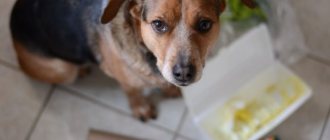Victoria Rashidovna Khazimulina
veterinarian Petstory
Vomiting of bile or yellow foam in a dog indicates serious problems with the pet’s health. Do not put off visiting a doctor, because the condition can quickly worsen. In this article we will tell you why a dog vomits yellow foam or bile, what accompanying symptoms can be caused by certain diseases, why vomiting can only occur in the morning and how to provide first aid to your pet.
What causes a dog to vomit?
The causes of vomiting are varied. In general, the causes of this phenomenon can be classified into several large groups that have similar symptoms:
- Poor nutrition.
- Foreign bodies.
- Poisoning.
- Stress.
- Worms.
- Infections and internal diseases.
Poor nutrition
Vomiting in dogs is often caused by mistakes that owners make in feeding their pets. In this case, usually, the help of a veterinarian is not required, and the unpleasant phenomenon goes away without treatment. It is enough to adjust the order of food intake and follow a few simple rules:
- Correctly determine the volume of each feeding, do not increase the dosage recommended for a particular breed, taking into account the age of the dog (puppies under 1 year of age usually require larger volumes with a gradual decrease in the amount until they reach the age of 2 years);
- Monitor the speed at which the dog consumes food: if the dog is prone to “quick swallowing”, it is recommended to use the training technique of forcibly interrupting consumption during each feeding; for example, give the command “sit” and remove the bowl for a short time (up to 7-10 seconds);
- Avoid feeding your dog prohibited foods - sweet, salty, fried, pork, sausages, some vegetables (onions), legumes and fruits containing a high percentage of sugar (grapes, figs, bananas, dried fruits).
Foreign bodies
Small bones (tubular), needles, chips, parts of toys that can get stuck in the esophagus or stomach are considered foreign bodies.
In the first case, the animal is able to cope with the stuck body on its own by coughing. If vomiting does not occur during the process, a visit to the veterinarian is not required.
It is not recommended to rush to help your pet, pat him on the back, or try to pull a foreign object out of the esophagus.
After a short time, the coughing will stop and the dog will spit out the offending substance. If expectoration continues or is accompanied by vomiting, you should consult a doctor immediately.
This is also mandatory if a foreign body is suspected of entering the stomach. We are talking about vomiting in situations where it is highly likely that the dog has swallowed a foreign object - garbage on the street, the contents of a trash can, pieces of shoes or furniture at home.
Poisoning
The most common cause of poisoning in dogs is the consumption of spoiled and low-quality food. To avoid serious consequences, it is necessary to carefully monitor the expiration dates on labels, purchase high-quality food and not use expired products.
Particular attention should be paid to your pet’s behavior on the street and any attempts to pick up trash should be suppressed. If you cannot cope with the problem on your own, it is recommended to seek help from a dog handler or walk the dog in special enclosed areas or on a leash.
Stress
Some dog breeds have a weak nervous system and find it difficult to tolerate any changes in their daily routine or moving to unfamiliar places. In such cases, it is necessary to contact a veterinarian, who will individually determine the appropriate sedatives.
Worms
The presence of worms and parasites in the body is often accompanied by vomiting. In order to avoid problems associated with this, it is advisable to carry out timely deworming.
For dogs that eat dry food, 1-2 times a year will be enough. For large dogs, which are most often fed raw meat, it is recommended to carry out parasite prevention once a quarter.
Infections and internal diseases
The most common infections include distemper, hepatitis, parvovirus enteritis, leptospirosis, and rabies . Signs of infection are lethargy, lack of appetite, vomiting, bloating, and severe pain. Puppies under 6 months of age are most susceptible to infectious diseases. It is possible to exclude these diseases by strictly following the vaccination schedule.
Internal diseases in dogs are varied. Most often, vomiting is accompanied by inflammatory diseases of the gastrointestinal tract, diseases of the central nervous system (meningitis), head injuries, and kidney problems. In all these cases, the diagnosis is made in a veterinary clinic. Self-medication is not allowed.
Diseases of the gastrointestinal tract
When a dog vomits bile, it is a sign of a number of conditions affecting the digestive system, including inflammatory diseases, ulcers, parasitic infections and some types of cancer.
- Inflammatory disease
- Parasites
- Ulcers
- Cancer
- Toxic substances
- Bacterial or viral infections
Vomiting bile in dogs can occur for many reasons. If there is bile (sometimes a yellow foamy liquid) in the vomit, if your dog vomits frequently or regularly, or if you notice one or more of the following symptoms in addition to biliary vomiting syndrome, then your dog is in serious danger. We need to take her to the vet as soon as possible.
Types of vomiting, symptoms and possible dangers
There are several types of vomiting in dogs. Let's consider them further.
Vomiting with white foam
This type of vomiting occurs when the dog is hungry and its stomach is empty. White foam is formed when the mucus in the stomach and the air that the dog swallows mix. One-time vomiting with white foam is not an alarming sign, does not require treatment and goes away after feeding. An exception is morning vomiting, which may be a consequence of gastrointestinal diseases. Most often, dogs with vomiting with white foam are diagnosed with gastritis and pancreatitis. Small breed dogs are susceptible to these diseases. The main recommendation is to increase the number of feedings (without increasing the daily intake).
Vomiting blood
It is considered the most dangerous symptom and requires immediate attention to a veterinarian.
In this case, the discharge in the vomit can be of different colors - from bright red to dark brown. The causes of such vomiting may be:
- Exacerbation of ulcers and internal bleeding;
- Foreign body in the stomach;
- Oncology;
- Poisoning by poisons.
In most cases, promptly seeking specialized help will help save your pet’s life. In this case, owners are recommended to describe to the veterinarian as accurately as possible the amount and frequency of vomiting, the saturation of the vomit, and the dog’s diet for 3 days before the onset of vomiting. It is also necessary to talk in detail about all changes in behavior - apathy, weakness, fever. The totality of symptoms will help in making a diagnosis and choosing the appropriate treatment.
Vomiting with mucus
Heat stroke or excessive exercise is accompanied by vomiting of mucus.
In the first case, the pet must first be provided with plenty of fluids and cooling (placed in a bathtub with cold water). In the second case, it is worth adjusting your training regimen.
Vomiting with mucus as a single symptom is not dangerous and occurs due to heat stroke. Signs of overheating are as follows:
- Heavy, frequent, intermittent breathing;
- Redness of the mucous membrane of the eyes;
- Increased salivation;
- Vomiting, diarrhea;
- Dry nose, increased temperature of the animal;
- In severe cases, loss of coordination, convulsions, loss of consciousness, and coma are observed.
Emergency treatment involves placing the dog in cold water. Additionally, it is necessary to cool the pet’s head by generously watering the skull in the direction from the frontal part to the neck. Water should not get into the dog's eyes, ears and nose.
Dogs with thick fur and prolonged active physical activity (service breeds) are usually susceptible to heatstroke. Therefore, it is recommended to reduce the intensity of training on hot days. Additionally, for all breeds it is necessary to follow the basic rules:
- Do not leave your dog in closed, unventilated areas (a car with closed windows, a cramped room or an unventilated cage);
- Monitor the availability of fresh water during the hot season;
- Do not overload your dog with heavy exercise.
If a dog loses consciousness during heatstroke, it must be shown to a veterinarian to avoid severe secondary consequences - kidney failure, brain damage
Vomiting with yellow foam
Vomiting with yellow foam, as well as vomiting with white foam, most often indicates an empty stomach. However, vomiting with yellow foam (bile) in some cases appears when the animal is infected with parasites.
Vomit gets a yellowish tint when bile and gastric juice mix. This is a natural phenomenon that occurs reflexively directly during a meal or shortly before feeding. Vomiting with yellow foam means that the dog's food portion was not enough. However, an isolated case is not an alarming symptom.
If the vomit does not contain pieces of food, a visit to the veterinarian is not required.
There is also no need to treat vomiting with yellow foam if it occurs after the dog has eaten grass during a walk. Thus, the animal cleanses the stomach of the remains of undigested food. Most often this happens if the diet contains a large amount of cereals (buckwheat, rice), or if prohibited foods enter the stomach.
The only correct solution in such a situation would be to reduce the amount of porridge and refuse food that is not intended for dogs. If the rest of your pet’s behavior has not changed, he is active and does not show signs of anxiety, we can assume that his health is not in danger.
Green vomit
A symptom that may indicate both the presence of an infection and diseases of the gastrointestinal tract.
If we are talking about the remains of undigested grass, such vomiting is not a cause for concern and is a seasonal way to naturally cleanse the stomach.
However, the appearance of green vomit without any green parts may indicate an intestinal obstruction or the presence of parasites. In this case, a thorough veterinary diagnosis is necessary.
Vomiting accompanied by diarrhea
Just as in the situation with vomiting blood, vomiting that is accompanied by diarrhea requires emergency placement of the pet in a hospital setting for a thorough examination. Most often, the combined symptom of vomiting and diarrhea indicates the presence of an infectious disease or severe poisoning.
Self-use of antidiarrheal drugs is not allowed. The pet must be provided with access to water. It is also necessary to observe the color of the stool and report this to the veterinarian. Yellowish and gray color indicates liver disease, black appears as a result of internal bleeding.
If we are talking about a puppy, the source of vomiting with diarrhea can be infectious diseases (distemper, infectious hepatitis, parvovirus enteritis, leptospirosis). Failure to see a doctor in a timely manner often leads to the death of your pet.
Vomiting and refusal to eat
Refusal to eat can be one-time or repeated. A single case does not require treatment. However, if vomiting continues for more than 2 days, and is also accompanied by various symptoms, you should seek the help of a specialist.
The most common situations in which a pet refuses to eat are:
- Refusal of food and water. If the dog is lethargic and inactive, we may be talking about intestinal obstruction or jaw damage. However, an equally popular reason for this behavior is the whim of a wayward pet. If your dog is happy to walk and play, there is no need to worry. On the other hand, there is also no need to indulge your pet’s whims. It is enough to ignore the whims for a while, and they will disappear on their own. Refusal of food and water is often observed in dogs with increased nervous excitability as a result of a radical change in the daily routine (shift in meal hours, change of food) or a change in environment (moving to another habitat, departure of the owners, placement in foster care). Dogs usually adapt to new conditions within 2-3 days. If this does not happen, the help of a veterinarian will be required.
- Refusal to eat and drink plenty of fluids. The main factor influencing this dog behavior is stress. Sedatives are used to relieve symptoms.
- Refusal to eat is accompanied by vomiting. This is a varied symptom indicating poisoning, the development of cancer, or a state of stress. In all cases, the dog must be shown to a veterinarian.
- Refusal of a pregnant bitch to eat. The most common cause is toxicosis, lasting from 2-3 days to 2-3 weeks. A dog suffering from toxicosis requires increased attention. If symptoms do not stop after a month, drug therapy for the condition will be required.
How to understand that it is poisoning
Poisoning is a serious disruption to the functioning of the body and can lead to the death of the pet.
To avoid serious consequences or death of the dog, in all cases of reasonable suspicion of intoxication, it is necessary to immediately take the animal to the clinic. If there is information about a suspected toxin (spoilt product, rat poison, arsenic), this should be reported to your doctor.
Clinical picture of poisoning:
- Vomiting and diarrhea.
- Drink plenty of fluids.
- Increased salivation.
- Intermittent breathing.
- Lethargy, trembling, convulsions, loss of coordination.
Signs of other internal diseases
Infectious (viral) diseases:
- Rabies: anxiety or apathy unusual for a pet, aggression, vomiting, salivation, increased body temperature;
- Distemper: lack of appetite, lethargy, pus in the eyes and nose, increased body temperature, dry skin, itching, vomiting.
- Infectious (bacterial) diseases: complete apathy, refusal to eat, vomiting with foam, diarrhea.
- Urinary system (mainly kidney disease): vomiting, diarrhea.
- Digestive system (gastrointestinal organs, liver, pancreas): nausea, vomiting (often after eating, vomit may contain pieces of food), pain in the abdomen, yellowing of the skin.
- Cardiovascular system: difficulty breathing, coughing, shortness of breath, arrhythmia, increased fatigue.
- Respiratory system: weakness, drowsiness, depression, shortness of breath, decreased appetite.
- Worms: itching in the anus (the dog “rolls” on the anus), constipation or diarrhea, sudden weight loss, faded fur.
If a prompt visit to the veterinarian is not possible
To provide first aid to a pet, you first need to ensure that the dog is calm. Remove the bowl of food for 1-2 hours. If you vomit repeatedly, do not delay visiting your doctor.
Under no circumstances should you give medications orally if you are vomiting repeatedly; the medications will not just come back out, but can also worsen the condition.
If vomiting is associated with heat stroke, you should place your pet in a cool place, wipe it with a damp cloth, and give free access to fresh water.
In cases with single vomiting, you need to change the frequency of feeding, that is, feed more often, but in smaller portions. In such situations, enveloping drugs can be used. However, the doses of the medicine must be calculated by a veterinarian, and many of them have contraindications.
In order to understand whether it is possible to give this or that medicine to your pet, you can contact Petstory therapists for an online consultation in the mobile application. You can install the application using the link.
What to do if your dog is vomiting - first aid
First aid for a dog in case of vomiting depends on the situation in which it occurs. The most dangerous situations requiring emergency intervention are poisoning. Usually the owner has 4-5 hours to save the dog.
Poisoning with rat poison or isoniazid:
- Don't feed. Accelerated absorption of the poison occurs with food.
- Induce vomiting - by forcibly pouring a large amount of water into the stomach or by mechanically pressing on the root of the tongue (provided that the dog allows this procedure). If the toxin is not known for sure, it is not recommended to use a saline solution, since salt can bind toxin particles.
- Make the dog swallow an adsorbent (activated carbon, enterosgel, polyphepan, polysorb).
- Apply a laxative salt solution (magnesium or sodium sulfate, 1 tbsp per 200 ml.).
- Inject intramuscularly the antidote: pyridoxine (it is recommended to have it in the first aid kit at all times).
- Immediately take the dog to the nearest veterinary clinic to be placed on a drip.
Help with non-food poisoning from chemicals and toxic gases involves making sure your pet drinks plenty of fluids. Next, the dog must be transported to the clinic.
How you can help at home
In the absence of new attacks and maintaining good health, it is enough to limit yourself to a starvation diet. Leave your pet without food for half a day, making sure to provide enough water. At the end of the fast, check your reaction to a sugar cube. If nausea does not return, continue feeding as usual.
In case of repeated attacks, it is better to entrust treatment to a veterinarian. Prior to examination, avoid feeding and replace water with ice cubes. Do not try to stop nausea with antiemetic drugs: they can blur the symptoms or worsen the patient's condition. To alleviate the condition, you can give your pet activated carbon or Enterosgel, which absorbs toxins.
If a visit to the clinic is not possible in the near future, try to prevent dehydration on your own. Prepare an isotonic solution by mixing water with salt and sugar, and feed it to the animal until you receive medical help. Intravenous Ringer's solution or 5% glucose solution are also suitable.
After removing a tick from your pet, drop everything and go for an examination, even if you are outside the city limits. If treatment is late, the dog’s chance of recovery is reduced to 5%.
Further diagnosis and treatment of vomiting in dogs
After the acute symptoms of poisoning or an attack of illness have been relieved, a set of diagnostic and therapeutic measures is carried out to rid the dog of vomiting.
Medical research is carried out in the following areas:
- Visual diagnosis of the animal - the condition of the coat, skin, mucous membranes;
- Rectal examination;
- External palpation of the organs of the urinary and digestive systems;
- General and biochemical blood test;
- X-ray (with contrast) of the gastrointestinal tract, abdominal cavity, chest;
- Ultrasound;
- Laparoscopy.
Treatment of vomiting, especially chronic cases, is carried out against the background of therapy for the underlying disease. General recommendations for all diseases can be considered changing your diet plan and protecting the body from dehydration. In this case, the complex of drugs is selected by the veterinarian on an individual basis, depending on the initial diagnosis.
Anti-vomiting medications for dogs
Drugs that can be used against vomiting in dogs:
| Name | Price | How to use |
| No-spa 0.04 (40 mg), tablet, 100 pieces | ~ 217 RUR/pack | It has an antispasmodic, myotropic effect, relieves spasms in diseases of the genitourinary system. Dosage – 1 tablet 40 mg/10 kg weight. |
| Smecta 3.0 (3g), powder, 10 pieces | ~ 151 RUR/pack | Strong adsorbent. Dosage – from 0.3 ml 2-3 times a day for small breed dogs, up to 3 sachets per day (the interval between doses should be 1-2 hours) for large dogs. |
| Omez 0.02 (20 mg), caps., 30 pieces (prescription drug) | ~ 177 RUR/pack | Effectively reduces secretion in the stomach, which leads to a decrease in acidity. Dosage – 1 mg/1 kg of weight. |
| Cerucal 0.01 (10 mg), tablet, 50 pieces | 122 RUR/pack | Antiemetic drug. Dosage – 0.7 mg/10 kg weight. It is prohibited to take in case of intestinal obstruction, as it can mask the main symptom. |
Diet food
After eliminating the urge to vomit and relieving the main pain symptoms, the dog is recommended to adjust its food intake.
- On the first day after stopping vomiting, a starvation diet and drinking regimen are practiced.
- In the next 5-7 days, feeding should be organized in small portions 5-6 times a day, gradually reducing the number of meals and increasing the volume.
- Most often, low-calorie foods are used during the recovery period (boiled rice, chicken, cottage cheese with a fat content of no more than 2% or special dietary food pre-moistened with water). Foods high in fat are completely excluded.
- The usual feeding regimen is possible 6-7 days after vomiting stops.
Preventive measures
Preventive measures consist of strict adherence to the following basic rules:
- Proper feeding appropriate to the breed, age and size of the dog;
- Compliance with the schedule of primary and repeated vaccinations;
- Training an animal in order to formulate a ban on collecting garbage on the street;
- Control by the owner over the pet during walking.
Preventive measures
Most diseases occur due to improper care, feeding and training of the dog. In order not to provoke vomiting or diarrhea, it is important to follow recommendations from puppyhood that will preserve the health of your beloved pets:
- Do not allow people to pick up foreign objects on the street or rummage through garbage heaps. The commands “Fu” and “No” should become law for the pet;
- Carry out deworming in a timely manner;
- Vaccination is an important preventive measure against severe infections. It must begin from early puppyhood;
- Owners must ensure that the animal does not swallow a foreign object and do not give sharp bones;
- Feed the dog only fresh food or dry food that is appropriate for its age;
- When walking, put a muzzle on a large dog. The accessory will help prevent the ingestion of toxic or spoiled substances.











